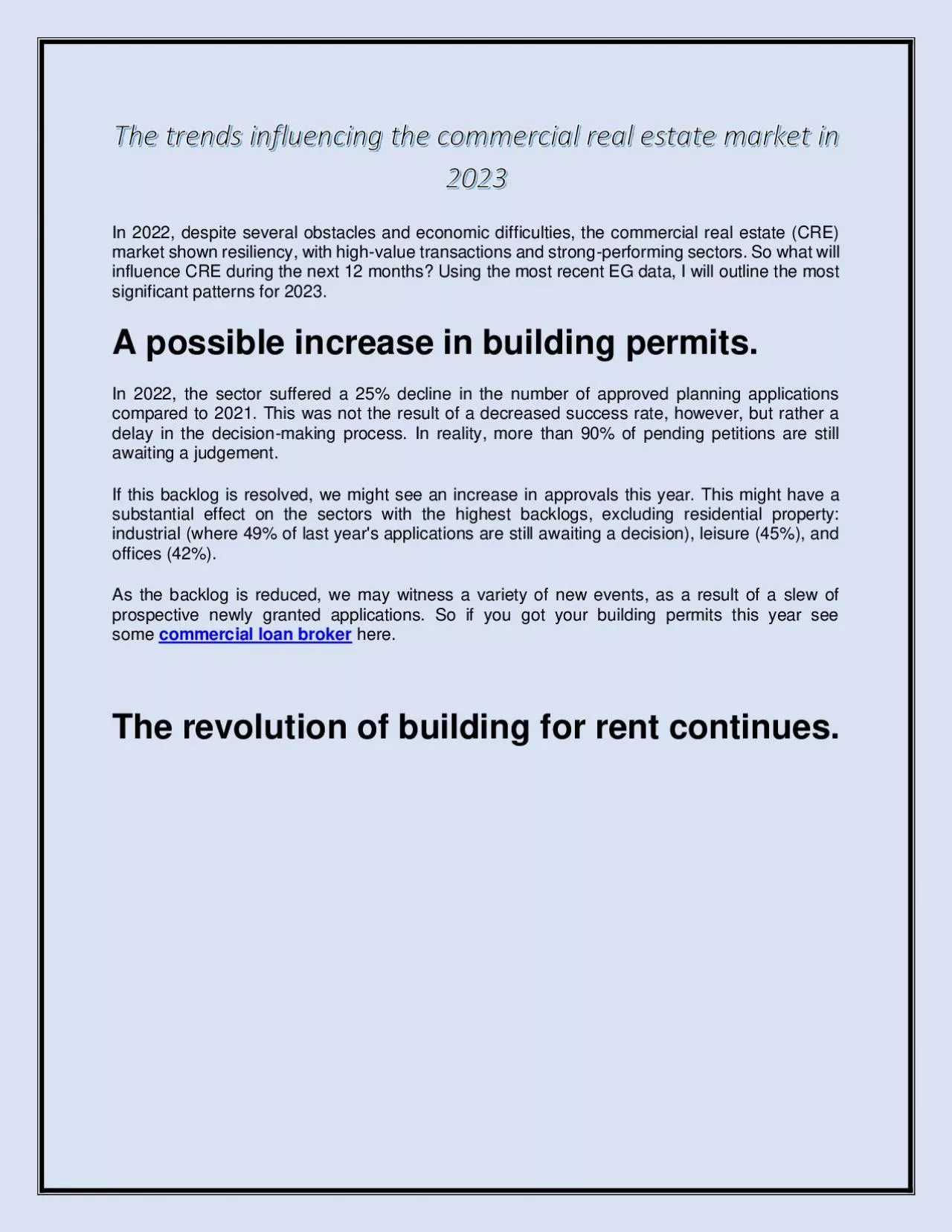

In 2022 despite several obstacles and economic difficulties the commercial real estate CRE market shown resiliency with highvalue transactions and strongperforming sectors So what will influence CRE during the next 12 months Using the most recent EG data I will outline the most significant ID: 972707
Download Pdf The PPT/PDF document "The trends influencing the commercial re..." is the property of its rightful owner. Permission is granted to download and print the materials on this web site for personal, non-commercial use only, and to display it on your personal computer provided you do not modify the materials and that you retain all copyright notices contained in the materials. By downloading content from our website, you accept the terms of this agreement.
In 2022, despite several obstacles and economic difficulties, the commercial real estate (CRE) market shown resiliency, with high - value transactions and strong - performing sectors. So what will influence CRE during the next 12 months? Using the most recent EG data, I will outline the most significant patterns for 2023. A possible increase in building permits. In 2022, the sector suffered a 25% decline in the number of approved planning applications compared to 2021. This was not the result of a decreased success rate, however, but rather a delay in the decision - making process. In reality, more than 90% of pending petitions are still awaiting a judgement. If this backlog is resolved, we might see an increase in approvals this year. This might have a substantial effect on the sectors with the highest backlogs, excluding residential property: industrial (where 49% of last year's applications are still awaiting a decision), leisure (45%), and offices (42%). As the b acklog is reduced, we may witness a variety of new events, as a result of a slew of prospective newly granted applications. So if you got your building permits this year see some commercial loan broker here. The revolution of building for rent continues. During the last five years, the number of build - to - rent (BTR) residences in the United Kingdom has doubled, and currently accounts for 7% of all new - build homes. This has led to a rise in the number of BTR operators and service providers, with established investors and new entrants, such as the retailer John Lewis, recognising the possibility and potential of this subsector. In December, EG's statistics revealed 69 new ren tal price records, following an increasing trend. This not only illustrates the expanding opportunities within the industry, but also a larger trend in EG data where new records are rising by 20 - 25% every month. As BTR continues to expand and revolutionise the private renting industry, investors and developers are starting to seek for new prospects outside of London and among BTR's regular clientele. Recently, BTR houses have been created and marketed towards families. With projects currently underway in Bo lton (Silkash) and Ellesmere Port (Glisk) that seek to provide family housing. While the market for single - family homes seems to be the next BTR hotspot, we anticipate the geographical distribution to persist into 2023. Mixed signals about purpose - built st udent housing The prospects for purpose - built student accommodation (PBSA) are more uncertain. December 2022 statistics revealed good growth numbers with total new rental price records to date up by 1,649 illustrating how active PBSA operators are. The amount of new records in the same month, however, implies that the rate of new listings is starting to drop. This might simply be that certain operators are more active than others, or that demand for PBSA is calmer near the conclusion of the first univer sity term ahead of the Christmas vacations. Owing to the cyclical nature of university lettings, we anticipate new records to begin to tumble over the coming months ahead of an upsurge towards the summer when prospective students get their A - Level results and start examining housing choices for the 2023/24 academic year. It is time for the sector to move on EPC Starting April 1st this year, commercial buildings that do not have an Energy Performance Certificate (EPC) grade of E or higher will not allowe d to be exchanged or leased. The Government law then improves the grade to C in 2027 and B in 2030. For commercial real estate owners this year, this may imply that approximately £2.5bn of rental revenue is under peril if their buildingâs EPC ratings are n ot upgraded. In fact, EGâs Radius data paired with EPC estimates reveal that 120m sq ft of commercial real estate will have failing EPCs in England by April. Not only will these properties not be allowed to be rented, but owners will also risk a fine of ab out 12.5% of the propertyâs rateable value. Itâs evident that this year the sector needs to react â adopting a proactive approach to boosting EPC ratings of buildings throughout the Country. Not only will this allow properties to continue to be leased and transferred beyond April, but it will also prepare the business for the more difficult legislation revisions in 2027 and 2030. For more queries about EPC call your finance brokers today. Cautious optimisms 2 023 will see the commercial real estate industry battle certain known difficulties, the revisions to EPC law being only one. With the continuous growth of the BTR industry and, ideally, an easing of the planning backlog, there will be several achievements and advancements to celebrate over the next 12 months.